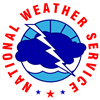Overview
A compact, slow moving piece of vorticity tracked through the Devils Lake region on the morning of April 5th. High resolution model guidance began to pick up on this potential during the late evening of the 4th. These models showed small areas of high QPF (around 0.25 inches per 1 hour panel) drifting into the Devils Lake area in the early morning hours of the 5th. This just did not seem possible, due to the lack of strong forcing (other than the vorticity lobe) and questionable moisture. However it did happen, and the charts and maps below give part of the picture. There was limited moisture and really no forcing other than the vorticity lobe. On the flip side, mid level lapse rates were high, indicating that convective snow rates were possible. These events are fairly rare to our forecast area, but they may be more common than we think. It is just that they occur over such small areas. If that area is rural or sparsely populated, we may never hear about it. The only way to keep on top of these situations is to make calls to verify what the radar is showing. In this instance (see the storm total map below), the snow totals were not being sampled well and were underdone. The radar may not have been in a spring convective mode and Benson County is well away from the radar. So these events are tricky.
There was a convective heavy snow event north of Fargo last year, with 18 inches of snow being the heaviest snow report. For this event, the office received a NWS Chat from the Fargo media, saying that they had received a report from Oberon, North Dakota, that 4.5 inches of snow had fallen there on the morning of April 5th, and that it had all melted during the day. The visible satellite imagery below shows that snow is still left in some areas of central Benson County in the evening of the 5th. If 4.5 inches of snow had melted during the day and satellite imagery still showed snow on the ground that evening, some areas must have received much more. Benson County is sparsely populated, and calls to who was around only yielded a maximum of 8 inches at Harlow. However, there could have been some areas with even more than that.
Photos & Video:
 |
| Graphicast issued during the Event |
Radar & Satellite:
 |
 |
 |
 |
|
00Z April 5, 2017 HRRR composite reflectivity |
Mayville base reflectivity |
Visible Satellite Imagery Shows the area of snow |
GOES 16 3 channels of water vapor & 1 IR channel |
Storm Reports
 |
 |
 |
| Observations from DVL | Local Storm Reports | Estimated Storm Total Snowfall |
Environment
Selected charts from SPC Mesoanalysis Page
 |
 |
 |
| 500mb | 700mb | 850mb |
 |
 |
 |
| 925mb | Mid Level Lapse Rates | Precipitable Water |
WPC Charts
 |
| Surface Map Animation |
 |
Media use of NWS Web News Stories is encouraged! Please acknowledge the NWS as the source of any news information accessed from this site. |
 |